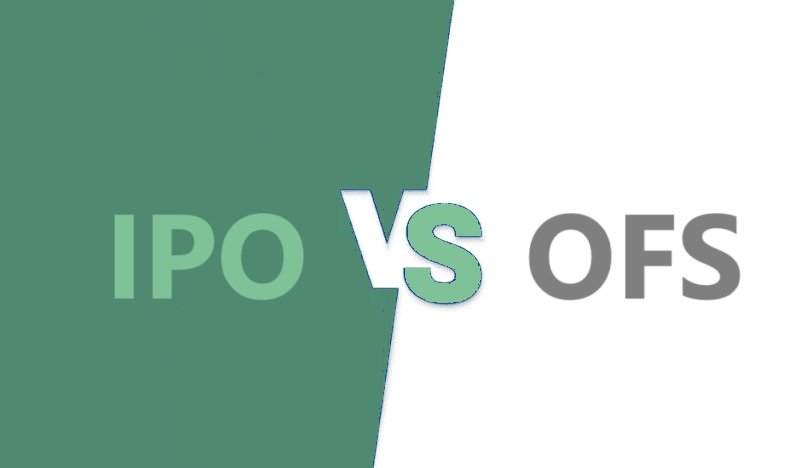
When companies seek to raise capital from the stock market, two popular methods often come into play: Initial Public Offering (IPO) and Offer for Sale (OFS). While both involve the sale of shares, they serve different purposes and follow distinct processes. Understanding the differences between IPO and OFS is crucial for investors, stakeholders, and companies alike.
What is an IPO (Initial Public Offering)?
An Initial Public Offering (IPO) is the process through which a private company offers its shares to the public for the first time and becomes a publicly traded entity. By launching an IPO, a company can raise fresh capital to fund its expansion, pay off debts, or achieve other corporate objectives. IPOs are considered a significant milestone for companies as they gain access to public markets and enhance their visibility.
Key Features of an IPO:
- Fresh Capital Infusion: IPOs primarily involve issuing new shares to raise capital.
- Regulatory Compliance: The process is heavily regulated and requires approval from market regulators like SEBI in India.
- Underwriting: Investment banks underwrite the IPO to ensure successful subscription.
- Pricing Methods: IPOs can be priced through a fixed-price mechanism or a book-building process.
- Time-Consuming Process: The process involves multiple stages such as due diligence, drafting of the prospectus, and roadshows.
Advantages of an IPO:
- Access to substantial capital for growth and expansion.
- Increased public awareness and credibility.
- Ability to use shares for mergers and acquisitions.
Disadvantages of an IPO:
- High costs related to underwriting and compliance.
- Extensive regulatory scrutiny and disclosure requirements.
- Pressure to meet shareholders’ expectations.
What is an OFS (Offer for Sale)?
An Offer for Sale (OFS) is a mechanism that allows existing shareholders, typically promoters or major investors, to sell their shares to the public. Unlike IPOs, OFS does not involve issuing new shares; it merely facilitates the transfer of ownership. The OFS route is often used by government entities and large corporates to meet regulatory requirements or unlock the value of their investments.
Key Features of an OFS:
- No Fresh Capital: The proceeds from an OFS go to the selling shareholders, not the company.
- Quicker Process: OFS is a faster method compared to IPO, often completed within a day or two.
- Eligibility: Only top-listed companies can use the OFS route, subject to certain guidelines.
- Transparent Pricing: Shares are sold at a floor price determined by the seller, and bids are collected in real-time.
- Low-Cost Process: OFS involves fewer regulatory requirements and lower costs.
Advantages of an OFS:
- Simple and fast mechanism for selling shares.
- Cost-effective with minimal documentation.
- Real-time bidding ensures price transparency.
Disadvantages of an OFS:
- No fresh capital infusion for the company.
- Limited to select shareholders (promoters and large investors).
- Market demand influences the success of the sale.
Key Differences Between IPO and OFS
| Aspect | IPO (Initial Public Offering) | OFS (Offer for Sale) |
|---|---|---|
| Purpose | Raise fresh capital by issuing new shares. | Enable existing shareholders to sell their shares. |
| Capital Infusion | Funds raised go to the company. | Funds raised go to the selling shareholders. |
| Process Duration | Lengthy and time-consuming process. | Fast process, often completed in 1-2 days. |
| Regulations | Heavily regulated with multiple disclosures. | Fewer regulatory requirements and lower compliance. |
| Pricing Mechanism | Fixed price or book-building method. | Floor price decided by the seller, real-time bidding. |
| Eligibility | Available to private companies going public. | Available to top-listed companies meeting SEBI norms. |
| Investor Participation | Open to retail, institutional, and foreign investors. | Primarily open to institutional and retail investors. |
| Underwriting | Often involves underwriting by investment banks. | No underwriting required. |
| Documentation | Requires detailed prospectus and disclosures. | Minimal documentation needed. |
When Should Companies Choose IPO or OFS?
- Choose IPO when:
- The company needs fresh funds for expansion, R&D, or debt repayment.
- The company seeks to enhance its brand visibility and market presence.
- The company is transitioning from private to public ownership.
- Choose OFS when:
- Promoters or large shareholders want to reduce their holdings.
- The company needs to comply with regulatory norms related to minimum public shareholding.
- The objective is to provide an easy exit route for existing investors.
Impact on Investors
- IPO Investors: Gain the opportunity to invest in a company from its initial public offering, potentially benefiting from future growth and appreciation in share value.
- OFS Investors: Get access to shares of established companies, often at a discounted price, with real-time bidding offering price transparency.
Both IPO and OFS come with inherent risks related to market volatility, demand-supply dynamics, and company performance.
Conclusion
While both IPO and OFS serve as channels for companies and shareholders to participate in the stock market, they differ fundamentally in purpose, process, and outcomes. An IPO is geared towards raising fresh capital and expanding business horizons, while an OFS facilitates the transfer of existing shares. Investors should carefully analyze the objectives, risks, and potential returns associated with each method before making investment decisions. Companies, on the other hand, must strategically choose the right method based on their financial needs, regulatory obligations, and long-term goals.
Disclaimer: This blog/Website is for educational purposes only and not investment advice. The securities mentioned are just examples, not recommendations. Do your own research before making any investment decisions.






